The latest issue of CCPIA Monthly Bulletin of Statistics of China Agrochemicals was just released. Here follows some major pesticides' price tendency and manufacturers' operation situation as reference.
1. Glyphosate
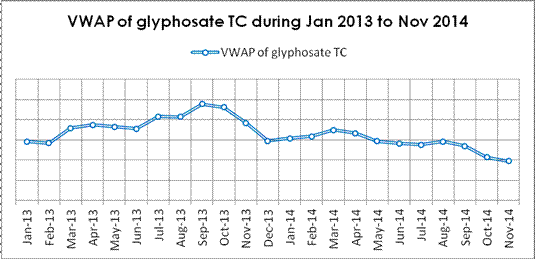
According to CCPIA Monthly Bulletin of Statistics of China Agrochemicals, in Nov, VWAP of glyphosate TC declined by 4.4% compared with that of Oct. Since the beginning of Q2, price of glyphosate kept dipping and the market did not look good during the past few months. AgroChemEx 2014 was held in the end of Oct. The event brought in some overseas and domestic orders to the glyphosate manufacturers. However it couldn't turn the market trends back to the flourish era. Based on some manufacturers' quoting price, glyphosate TC price is increasing in Dec.
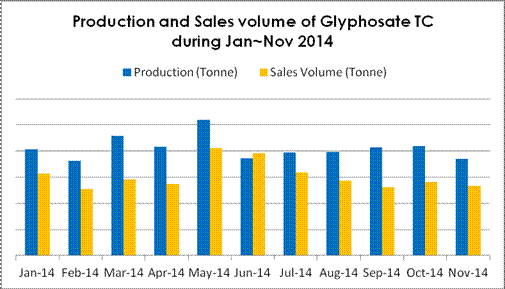
In Nov, with two less manufacturers operating, output of glyphosate TC fell by 11.8% MoM, and sales volume declined by 5.0% MoM. According to a big pesticide manufacturer, Yangnong Chemical, its dicamba plant has begun pilot production. It's estimated that the dicamba plant will start operating from Q1 2015 (with production capacity 6500 tonnes per year). Since the global market demand of dicamba is increasing fast, dicamba market may have a good prospect in the near future, which will also bring up glyphosate market, especially in the aspect of GMO business.
2. Paraquat
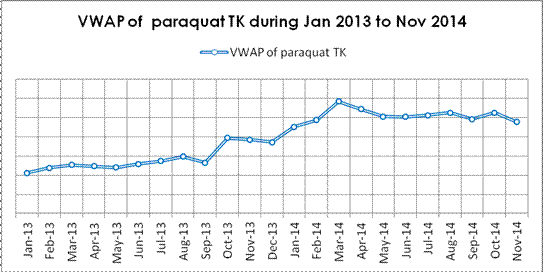
According to CCPIA Monthly Bulletin of Statistics of China Agrochemicals, in Nov, VWAP of paraquat TK declined by 6.7% compared with that of Oct. Seen from the whole trend during the past two years, paraquat price has been keeping stable since Q2 2014. The ban of paraquat AS (Announcement No. 1745) didn't impact the market that much. However seen from short term trend, overseas demand of paraquat kept same level with former years, while domestic demand didn't play that well. Hence it may be a little tough for paraquat manufacturers in the near future.
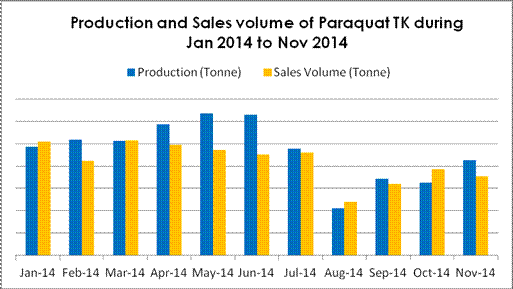
The ban did impact output of paraquat TK to some extent. Since Jul 2014, output of paraquat TK fell significantly, even worse in Aug. However during the past four months, output and sales volume of paraquat TK was increasing month-on-month. In Nov, output increased by 30%, while sales volume dipped by 8% compared with that of Oct. In Dec, RedSun, one of the largest paraquat manufacturers in China, launched its new product, "Dujiaxing' (20% paraquat GW) to the market. It's the only alternative commercial formulation of paraquat AS till now.
3. Chlorpyrifos
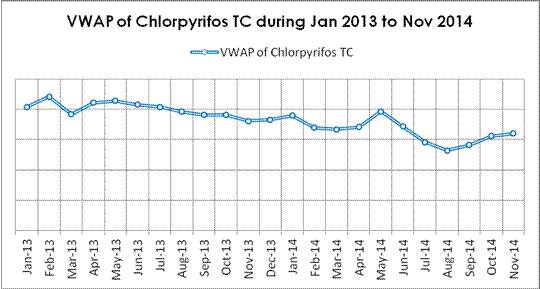
According to CCPIA Monthly Bulletin of Statistics of China Agrochemicals, in Nov, VWAP of chlorpyrifos TC increased by 4.8% MoM. Because of the AgroChemEx 2014, large amount of orders came into China chlorpyrifos market, and price of chlorpyrifos TC has been triggered since then.

In Nov, there are seven manufacturers operating to produce chlorpyrifos TC in China, same as that of Oct. Output of chlorpyrifos TC declined by 12.8% compared with that of Oct, while sales volume increased by 3.3%. Seen from each manufacturer's VWAP of chlorpyrifos TC, four of them increased in Nov, and others kept same with that of Oct. However since the overseas demand for chlorpyrifos didn't play well in Dec, and production was impacted under the strict environmental protection policy, it seems the increasing trend won't last long in the near future.
4. Imidacloprid

According to CCPIA Monthly Bulletin of Statistics of China Agrochemicals, in Nov, VWAP of imidacloprid kept same as that of Oct. During the past 11 months in 2014, price of imidacloprid TC increased in Q2, afterwards, the declining trend continued till now. Actually, the overall tendency of imidacloprid TC since the beginning of 2013 is declining. Two main factors led to the declining. Firstly, farmers in China grow in small scale. Most of them are still in vulnerable group which cannot afford pesticides with high price. Secondly, quality of imidacloprid products in China pesticide market is basically the same. Hence some manufacturers turn to bring down their price to compete with each other.

In Nov, there were 14 manufacturers operating to produce imidacloprid TC, one more than that of Oct. And output increased by 11%, sales volume up by 24% month-on-month. Meanwhile, export volume of imidacloprid TC increased by 6%, and export value up by 1% than that of Oct. According to quoting price in Dec, imidacloprid market is keeping stable. Quoting prices of different manufacturers are drawing close to one another.
5. Carbendazim
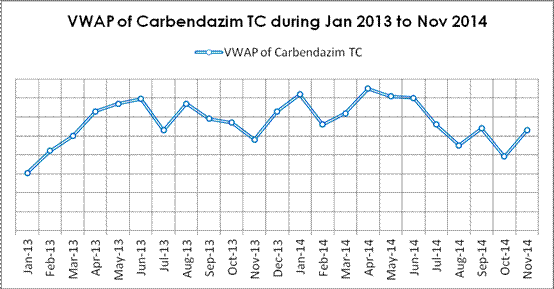
According to CCPIA Monthly Bulletin of Statistics of China Agrochemicals, in Nov, VWAP of carbendazim TC increased by 5% month-on-month, back to the same level with that of Sep. During the past few months, carbendazim market was in downside price fluctuations. AgroChemEx 2014 stimulated transaction volume of carbendazim to some extent, however not in overseas, mostly in domestic market.
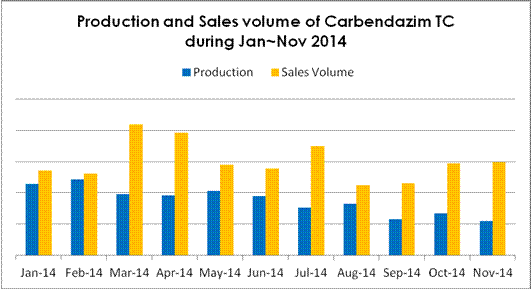
In Nov, with four manufacturers operating, output of carbendazim TC declined by 18%, while sales volume up slightly by 1% month-on-month. Seen from the chart above, sales volume of carbendazim TC is always larger than production during 2014, which shows that the market has been keeping digesting stock of carbendazim. According to the Bulletin, export volume declined significantly by 31%, and export value down by 30%.
6. Chlorothalonil
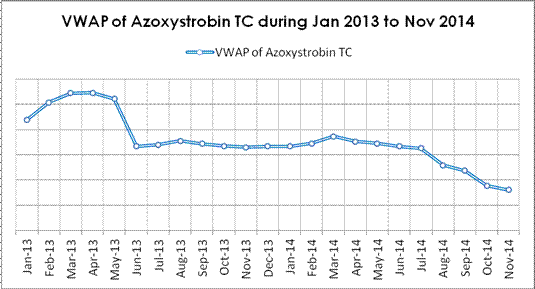
According to CCPIA Monthly Bulletin of Statistics of China Agrochemicals, in Nov, VWAP of azoxystrobin TC declined slightly by 2% than that of Oct. Actually since Q2, price of azoxystrobin TC has kept going down. With domestic production capacity reaching over 7000 tonnes per year, azoxystrobin market in China is facing the dilemma of overwhelmed capacity & slight demand at home and abroad. VWAP in Nov is over 20% lower than that of Mar 2014 (the highest point this year).

In Nov, there were seven manufacturers operating, both output and sales volume increased significantly. Output of azoxystrobin TC increased by 19% month-on-month, and sales volume up by 73%. Since the export volume basically kept the same level with that of Oct, domestic sales growth contributed mostly to the overall increasing. Till now, there are 63 registrations of azoxystrobin TC in China, increased by 50% year-on-year. The enthusiasm of increasingly manufacturers cannot be controlled, which may cause a long-term of declining in China azoxystrobin market in the future.